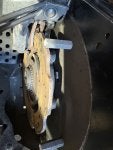Hi everyone,
I’m pretty new to snowmobile, this will be my second season.
While doing maintenance on my sled, I noticed that the brakes were REALLY due for replacement! I also found that the brake pistons seem to be stuck or seized, maybe because I left the brake engaged over the summer, I’m not sure 😅.
I tried pushing the pistons back in a bit with a flat screwdriver, but as soon as I press the brake, they get stuck again. So, while being there i removed the old, worn-out brake pads, flushed out all the old DOT 4 brake fluid, and cleaned the reservoir.
What i need to do now ?
I’m pretty new to snowmobile, this will be my second season.
While doing maintenance on my sled, I noticed that the brakes were REALLY due for replacement! I also found that the brake pistons seem to be stuck or seized, maybe because I left the brake engaged over the summer, I’m not sure 😅.
I tried pushing the pistons back in a bit with a flat screwdriver, but as soon as I press the brake, they get stuck again. So, while being there i removed the old, worn-out brake pads, flushed out all the old DOT 4 brake fluid, and cleaned the reservoir.
What i need to do now ?







